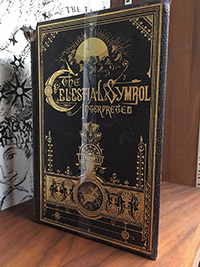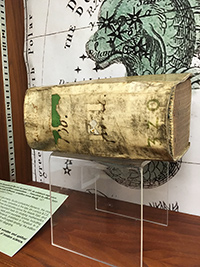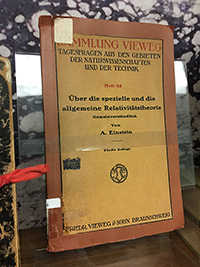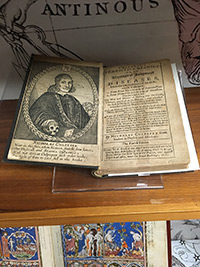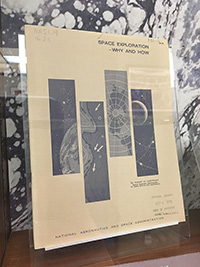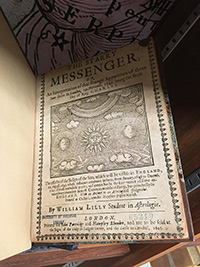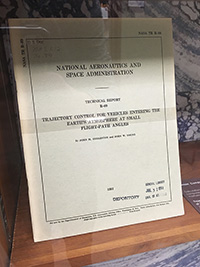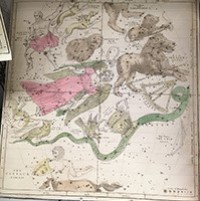The Splendor of the Heavens: Centuries of Changing Perspectives on the Cosmos
A new sister exhibit is now on display in the Special Collections Reading Room through May 2018. Featured in the two cases are items that highlight the culture of astronomy and some of mankind’s most brilliant minds, such as Albert Einstein and Steven Hawking, who wrote on the endless mysteries of the heavens.

The first case, entitled "A Universe of Culture," brings together titles of some of astronomy's greatest minds.
Cosmology, physics, mathematics, astrology, religion, and, of course, astronomy are all intertwined in the complex history of thinking about our own galaxy and all that exists within as well as beyond.
The universe, and the unknown that lies within, has always inspired and piqued the curiosity of humankind. The rhythm of the calendar created an order to the earth and sky. The moon predicted tides. The prospective connections between distant celestial bodies and people's lives were as infinite as scientists believe the Universe to be. From the first appearance of books, people used this medium to record their speculations, calculations, and beliefs about the meaning and import of all they observed in the night sky. Some of this early work can now be easily dismissed; other documents became the stepping-stones for great thinkers who followed.
One of the items featured in this exhibit is Euclid's work from Antiquity. The Greek founder of geometry, Euclid completed Elements, the most famous of his six surviving works sometime in the late 4th century B.C.E. Fragments survived in archives and libraries across the Middle East, and it remained one of the most important texts for studying mathematics well into the 20th century. Many early print examples survive, including this 1607 complete collection of Elements published in Frankfurt. In a later, although still early rebound format with pigskin binding, this edition includes many crisp engravings of geometric diagrams.
Another item of interest is Herbert W. Morris' The Celestial Symbol Interpreted. It is not hard to imagine how a familiarity with astronomy and the recognizable patterns of stars like the captivating Milky Way, the Big Dipper and her diminutive namesake, and the scene stealing North Star could lead to fertile minds to conceiving various astrological theories.
Astrology, in its many manifestations, has continued to intrigue and influence individuals for centuries including, apparently, John Gould Fletcher, writer and critic, and Pulitzer Prize winner. These hand drawn astrological charts were developed specifically by W. Franklands who also authored a number of texts on astrology.
Also featured in the exhibit is Pliny the Elder's Natural History; serving as a model for later encyclopedias and indexes, this is a comprehensive history of the world as it was known to Roman thinkers that touches on many subjects of science including astronomy, botany, and geology, while also addressing magic and spirituality. Written around 77 AD, Pliny's lone surviving work was a foundational book for European scholarship, with more than 200 manuscripts conveying the voluminous, yet disjointed text through the Middle Ages. Consequently it was one of the earliest and most frequently reprinted Classical texts in the decades after the invention of movable type. This copy, published in Basel in 1530, includes evidence of centuries of use by scholars including substantial marginalia and other vestiges of its long history such as manicules, hand-shaped highlighting notations.
Other items in this particular case include William Lily's The starry messenger (1644), Nicholas Culpeper's Semeiotica Uranica: or, an Astrological Judgement of Diseases (1671), and Daniel H. Weiss's The Morgan Crusader Bible, commissioned by King Louis IX circa 1250.
The complementary case, entitled "Science Takes Hold," contains the writings of some of science's most groundbreaking scholars.
As human beings, both our curiosity to explore and our need to understand our universe have been key components in some of our biggest scientific discoveries, laws, and theories. This exhibit illustrates the symbiotic relationship between physics, mathematical sciences, and space science to push forward our knowledge of the universe.
Exhibit items include some of the most notable theoretical works by great scientific thinkers, including Sir Isaac Newton's laws of motion and gravity, Albert Einstein on theories of relativity, Stephen Hawking on black holes and the creation of the universe, and Kepler on laws of planetary motion. More practical publications, such as celestial navigation manuals and technical reports form the National Aeronautics and Space Administration (NASA), show how these scientists' work have been used both to find one's way on Earth as well as to support American space flights, incorporating the complementary mathematical knowledge needed for these adventures.
Many famous scholars and their published works are housed in this exhibit. Albert Einstein in particular, whose theory of relativity serves as a pillar of modern physics, is represented by several different books and articles. The Uber die Spezielle und die Allgemeine Relativitatstheories (Gemeinverstandlich), a three part book written about Einstein covering special relativity, general relativity, and considerations of the universe as a whole, can be found alongside his article "Jahrbuch der Radioaktivitat und Elektron." This article, published in 1907, was Einstein's' sequel to his first paper in 1905 and is considered an extensive survey on the theory of relativity.
Another item of interest is Arthur M. Harding's Astronomy: The Splendor of the Heavens Brought Down to Earth, published in 1935. Harding, first Arkansas-born president of the University of Arkansas, was a professor of mathematics and astronomy at the University.
In addition to some of these theoretical works, the exhibit includes practical works such as the technical report, Trajectory Control for Vehicles Entering the Earth's Atmosphere at Small Flight-Path Angles, Edgar M. Cortright's Space Exploration: Why and How, 1965, and Henry Draper's On the Construction of a Silvered Glass Telescope, Fifteen and a Half Inches in Aperture, and its Uses in Celestial Photography. Fayetteville locals will also be interested in Carol Schwarz and Derek Sears' Guide to the Sampling of the Fayetteville Meteorite.
(Click thumbnail image to enlarge.)
